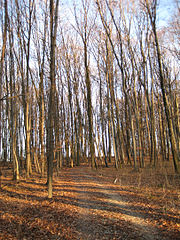Forest plantations
Forest plantations, generally intended for the production of timber and pulpwood increase the total area of forest worldwide. Commonly mono-specific and/or composed of introduced tree species, these ecosystems are not generally important as habitat for native biodiversity. However, they can be managed in ways that enhance their biodiversity protection functions and they are important providers of ecosystem services such as maintaining nutrient capital, protecting watersheds and soil structure as well as storing carbon. They may also play an important role in alleviating pressure on natural forests for timber and fuelwood production.Forest categories
A temperate deciduous broadleaf forest, the Hasenholz, southeast of Kirchheim unter Teck, Baden-Württemberg, Germany.

Redwoods in old growth forest in Muir Woods National Monument, Marin County, California.
Temperate and boreal forest types
- Evergreen needleleaf forest - Natural forest with > 30% canopy cover, in which the canopy is predominantly (> 75%) needleleaf and evergreen.
- Deciduous needleleaf forests - Natural forests with > 30% canopy cover, in which the canopy is predominantly (> 75%) needleleaf and deciduous.
- Mixed broadleaf/needleleaf forest - Natural forest with > 30% canopy cover, in which the canopy is composed of a more or less even mixture of needleleaf and broadleaf crowns (between 50:50% and 25:75%).
- Broadleaf evergreen forest - Natural forests with > 30% canopy cover, the canopy being > 75% evergreen and broadleaf.
- Deciduous broadleaf forest - Natural forests with > 30% canopy cover, in which > 75% of the canopy is deciduous and broadleaves predominate (> 75% of canopy cover).
- Freshwater swamp forest - Natural forests with > 30% canopy cover, composed of trees with any mixture of leaf type and seasonality, but in which the predominant environmental characteristic is a waterlogged soil.
- Sclerophyllous dry forest - Natural forest with > 30% canopy cover, in which the canopy is mainly composed of sclerophyllous broadleaves and is > 75% evergreen.
- Disturbed natural forest - Any forest type above that has in its interior significant areas of disturbance by people, including clearing, felling for wood extraction, anthropogenic fires, road construction, etc.
- Sparse trees and parkland - Natural forests in which the tree canopy cover is between 10-30%, such as in the steppe regions of the world. Trees of any type (e.g., needleleaf, broadleaf, palms).
- Exotic species plantation - Intensively managed forests with > 30% canopy cover, which have been planted by people with species not naturally occurring in that country.
- Native species plantation - Intensively managed forests with > 30% canopy cover, which have been planted by people with species that occur naturally in that country.
- *Unspecified forest plantation - Forest plantations showing extent only with no further information about their type, This data currently only refers to the Ukraine.
- *Unclassified forest data - Forest data showing forest extent only with no further information about their type.




0 Response to "Forest plantations"
Post a Comment